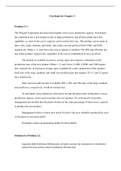Exam (elaborations)
Test Bank Introduction to Operations Research 11th Edition by Frederick S. Hillier, Gerald J. Lieberman Chapter 3-28|Complete Guide A
- Course
- Institution
- Book
Test Bank Introduction to Operations Research 11th Edition by Frederick S. Hillier, Gerald J. Lieberman Chapter 3-28|Complete Guide A
[Show more]



